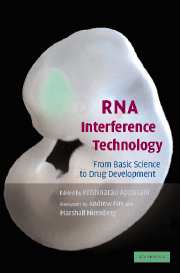Book contents
- Frontmatter
- Contents
- Foreword by Andrew Fire
- Foreword by Marshall Nirenberg
- List of Contributors
- Introduction
- Section one Basic RNAi, siRNA, microRNAs and gene-silencing mechanisms
- Section two Design, synthesis of siRNAs
- 6 Design and synthesis of small interfering RNA (siRNA)
- 7 Automated design and high throughput chemical synthesis of siRNA
- 8 Rational design of siRNAs with the Sfold software
- 9 Enzymatic production of small interfering RNAs
- Section three Vector development and in vivo, in vitro and in ovo delivery methods
- Section four Gene silencing in model organisms
- Section five Drug target validation
- Section six Therapeutic and drug development
- Section seven High-throughput genome-wide RNAi analysis
- Index
- Plate section
- References
6 - Design and synthesis of small interfering RNA (siRNA)
Published online by Cambridge University Press: 31 July 2009
- Frontmatter
- Contents
- Foreword by Andrew Fire
- Foreword by Marshall Nirenberg
- List of Contributors
- Introduction
- Section one Basic RNAi, siRNA, microRNAs and gene-silencing mechanisms
- Section two Design, synthesis of siRNAs
- 6 Design and synthesis of small interfering RNA (siRNA)
- 7 Automated design and high throughput chemical synthesis of siRNA
- 8 Rational design of siRNAs with the Sfold software
- 9 Enzymatic production of small interfering RNAs
- Section three Vector development and in vivo, in vitro and in ovo delivery methods
- Section four Gene silencing in model organisms
- Section five Drug target validation
- Section six Therapeutic and drug development
- Section seven High-throughput genome-wide RNAi analysis
- Index
- Plate section
- References
Summary
Efficient RNA interference (RNAi) depends on siRNA design and synthesis
RNAi is a powerful technology with tremendous utility for functional genomic analysis, drug discovery strategies and therapeutic applications (Appasani 2003). While this pathway for post-transcriptional gene regulation is ubiquitous among eukaryotes, species-specific variations in the mechanism impact the utility of this pathway. These species-specific distinctions have strong implications with regard to the design, production, and delivery of the functional silencing intermediates. For example, in Caenorhabditis elegans (C. elegans), simple exposure by soaking (Tabara et al. 1998; Timmons and Fire 1998), feeding (Fraser et al. 2000; Timmons et al. 2001), or injecting (Fire et al. 1998) the nematode with long dsRNA is sufficient to induce prolonged and potent gene knockdown. Silencing efficiency appears to be due to siRNA-primed amplification of additional dsRNA from the mRNA target resulting in a secondary pool of Dicer processed duplexes (Sijen et al. 2001; Tijsterman et al. 2002). This mechanism is characteristic of post-transcriptional gene silencing in nematodes and other lower eukaryotes and is mediated by an RNA-dependent RNA polymerase [(RdRP) (Sijen et al. 2001; Martens et al. 2002)]. Invariably, several of the newly generated siRNAs will be capable of proficient gene-specific knockdown thereby eliminating the need to carefully design and synthesize a single siRNA silencing intermediate.
In mammalian cell culture models, preliminary attempts to induce RNAi using long dsRNA met with limited success (Tuschl et al. 1999; Caplen et al. 2000; Zhao et al. 2001).
Information
- Type
- Chapter
- Information
- RNA Interference TechnologyFrom Basic Science to Drug Development, pp. 103 - 117Publisher: Cambridge University PressPrint publication year: 2005
